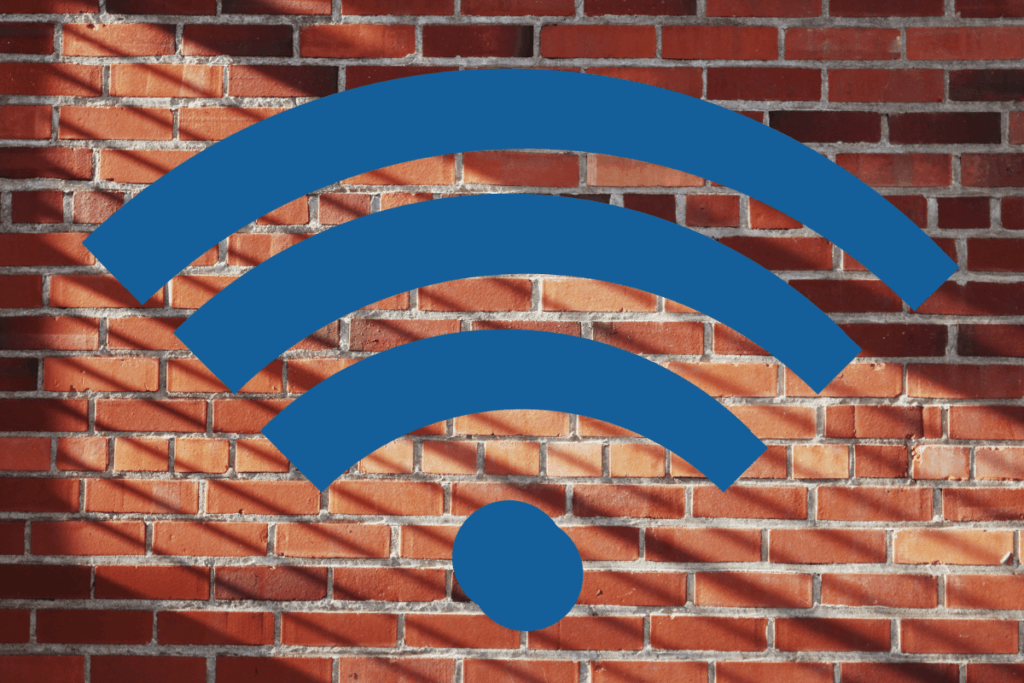Have you ever wondered what today’s world of connectivity would be like without the comforts of Wi-Fi-ready gadgets? If Wi-Fi keeps most of us connected even while we are on the go, it’s reasonable to wonder if there are barriers that block or hinder Wi-Fi connection. You may even keep on wondering: does Wi-Fi go through walls? If so, how do the walls affect the signal?
Wi-Fi signals can generally penetrate through walls, and some walls are easier to penetrate than others. In terms of how deep it can penetrate barriers, the strength of Wi-Fi connectivity largely depends on the thickness and, in most instances, the type of material was used to make the walls.
There is a reason why your fancy hotel, Air BNB, or a nearby Starbucks have Wi-Fi connectivity even if you are not situated close to their modem. Oftentimes, an efficient router will provide effective distribution of the wider Internet system. Read on to find out more about modems, routers, and why some buildings have smoother Wi-Fi connectivity than others.

What Are Modems And Routers?
Do you wonder how your portable electronic gadgets are picking up Internet signals even if you are in areas that do not have an internet connection? Part of this has to do with the fact that phone networks provide ready internet connectivity through cell towers, even without Wi-Fi. But how about other electronic gadgets that are not subscribed to a phone network? How do modems and routers play into this?
The modem is the box that connects a subscribed home or small business network to the internet, and modems are the main source of a building or a home’s internet connectivity.
A router is a box that allows wired and wireless electronic devices of a home or a building to use an internet connection from the modem. Routers also enable various devices to connect with each other.
It is interesting to know what the mostly unseen boxes of modems and routers do to help make your life easier when you want to connect to the world wide web. These unsung heroes of connectivity seem to perform miracles to make your life better. Continue below to find out if modems and routers can help you avoid obstructions and interferences to your Internet connections.
What Causes Wi-Fi Obstruction?
While sipping your favorite cold brew at a nearby Starbucks, you may have wondered: why do I have an excellent Wi-Fi connection here? You were also curious about the fact that Wi-Fi connectivity is not always the best when you are traveling for work. You thought it was all about the price you pay for your network provider subscription, but is it?
Internet obstruction and interference have little to do with the efficiency of your network provider. The main causes of internet blockage and intrusion in a Wi-Fi network are a direct result of the thickness and the materials used in constructing the walls of a building.
Wi-Fi signals can penetrate physical dividers but are affected by depth and certain materials used during construction.
Modems and routers are the unseen heroes of your portable connectivity. But both are helpless if the walls are too thick or if the materials used in making the walls are just too tough for Wi-Fi signals to penetrate. Keep reading to figure out how thick a wall or what materials used to create the wall can affect your Wi-Fi connectivity.
How Is Wi-Fi Strength Measured?
After establishing awareness that Wi-Fi signals are affected by the make and thickness of materials that serve as room dividers and barriers, are you curious about how Wi-Fi strength measured?
How will the strength of your network Wi-Fi hold up against barriers made of materials that deter Wi-Fi connection?
Wi-Fi power is measured in decibel milliwatts (dBm) and expressed in negative values.
| Wi-Fi Signal Strength | Quality | Good for |
| -30.0000 dBm | Maximum signal strength. | |
| -50.0000 dBm | Excellent signal strength. | |
| -60.0000 dBm | Very good reception strength. | |
| -67.0000 dBm | Good, reliable signal. | The minimum for most services. Good for voice over Wi-Fi and non-HD video streaming. |
| -70.0000 dBm | Weak signal. | Email checks and light browsing. |
| -80.0000 dBm | Very weak, unreliable signal strength, | Good for connecting to network only. |
| -90.0000 dBm | Very low chances of connecting to network at this level. |
(Newth, 2018)
Now that you know how Wi-Fi strength is measured, you can strategically place devices to maximize your connectivity strength. If you experience interference, you will understand what causes it and can remedy the situation. Keep reading to find out what type of materials affect Wi-Fi connections.
What Materials Affect Wi-Fi Signals?
You may be one of those who travel for work and depend largely on a Wi-Fi internet connection to get the job done. Since you know the type of construction materials that affect Wi-Fi signals, you now need to know how to prepare yourself if you are on the road and need to get an internet connection, especially for business or work.
Construction materials made of concrete create the toughest barriers for Wi-Fi signals to penetrate. Materials that can also adversely affect Wi-Fi connectivity include:
- Masonry
- Brick
- Timber
- Double-glazed glass
Thickness of material will vary. A more accurate indicator in determining Wi-Fi resistance is material impermeability. The least porous materials are the most resistant to Wi-Fi. Below are examples:
| Materials That Affect Wi-Fi | Approximate loss of decibels using 5 GHz bandwidth |
| Concrete Slabs (8 inches thick) | 55.0000 |
| Fortified concrete | 53.8000 |
| Bricked concrete | 39.9000 |
| Bricked masonry block | 32.6000 |
| Concrete (4 inches thick) | 26.0000 |
| Bricks | 15.3000 |
| Masonry | 15.0000 |
| Timber material | 3.3000 |
| Glass products | 0.0688 |
| Drywall panels | ~ 0.0000 |
| Plywood material | ~ 0.0000 |
It is interesting to know that some materials can block or suppress the strength of Wi-Fi. We all thought that technology knows no barriers! Well, we thought wrong. Certain construction materials in our homes and buildings serve as barriers to our Wi-Fi connectivity. But is it just building materials that interfere with Wi-Fi? Keep reading to see what other factors hinder connectivity.
How Does Wi-Fi Travel?
You may have noticed that every time your microwave oven is on, your Wi-Fi connection is slower. This has kept you guessing as to what other potential factors can adversely affect your wireless connectivity. You are interested to know how Wi-Fi signal strength and speed are affected by various factors.
Wi-Fi signals travel in different bandwidths. Wireless connectivity frequency bands travel in:
- 2.4 GHz
- 3.6 GHz
- 5 GHz
A lower frequency bandwidth has a longer connectivity range but is slower at data transmission. The higher frequency bandwidth transmits data faster but has a limited range.
Every time you use Wi-Fi and experience interference, it does help to know how to remedy the situation. Is your frustration because you want faster downloads, or are you hoping for a stronger connection? Going back to the microwave, you cannot help but ask: How is Wi-Fi connection affected by other factors besides the materials used for walls?
Does Bandwidth Affect Connectivity?
Now that you know that wireless signals travel at different frequencies, do you know how connections are affected per bandwidth? There are different ways your Wi-Fi connections can be hindered. Chances are, speed, strength, or even a combination of the two can have interference depending on what bandwidth your network provider uses.
The bandwidth frequency at which Wi-Fi travels determines the type of connectivity interference.
Possible sources of signal obstruction in 2.4GHz frequency band:
- Microwave appliances
- 2.4GHz wireless telephones
- Incandescent light bulbs
- 2.4GHz camcorders
- Elevators
- Cauterizing machines
- Plasma cutting devices
- Bluetooth aided devices
- Adjacent 802.11, 802.11b, or 802.11g Wireless Local Area Networks
- Wireless Internet Service Providers
Potential sources of interference in the 5GHz frequency bands include the following:
- 5GHz wireless telephones
- Radio Detection And Ranging
- Perimeter sensing devices
- Satellites using digital technology
- Adjacent 802.11a or 802.11n Wireless Local Area Networks
- 5GHz Wireless bridges
Depending on the frequency your Wi-Fi connection travels, the list above provides factors that may interfere with and block your signal. It is important for you to be aware of what to avoid and minimize if you want to maximize the strength of connectivity and the speed of your network connection.
Does the Raspberry Pi computer use Wi-Fi?
I’ve written pretty extensively on the Raspberry Pi line of computers on this website. If you’re wondering about the Wi-Fi capabilities of these single board computers, you should check out my guide about their capabilities here.
Conclusion:
We have established the fact that Wi-Fi signals go through walls and barriers. However, it will eventually depend on the thickness and, more accurately, the type of materials used for building such barriers to determine if wireless signals can penetrate them. It seems the less porous and more solid the barriers and walls, the more interference and even blocking of your wireless signals you will experience.
Wireless signals also travel in different frequencies. How Wi-Fi signals are affected can and will be influenced by other factors outside of the type of materials used for barriers that separate rooms in houses and buildings. For you to maximize signal strength and speed of connectivity for your Wi-Fi devices, your routers must be placed near the modem or in areas where barriers are more porous with minimum electrical and electronic appliances that may also suppress maximum connectivity.
References:
Dos and Don’ts of Wi-Fi connectivity: Maximizing Range and Reception. (n.d.). Retrieved from Mistral Solutions: https://www.mistralsolutions.com/articles/dos-donts-wi-fi-connectivity-maximizing-range-reception/
Modem vs. Router: What’s the Difference? (2021, February 11). Retrieved from Wirecutter: https://www.nytimes.com/wirecutter/blog/modem-vs-router/
Newth, J. D. (2018, February 28). Wi-Fi Signal Strength: What Is a Good Signal And How Do You Measure It? Retrieved from Eyesaas.com: https://eyesaas.com/wi-fi-signal-strength/
Which Building Materials Can Block Wi-Fi Signals? (2019, December). Retrieved from Eye Networks: https://eyenetworks.no/en/wifi-signal-loss-by-material/
